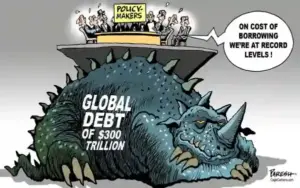Rising Debt Levels
Rising Debt Levels and Interest Costs: Governments worldwide are experiencing the highest debt servicing costs since 2007. The Organisation for Economic Co-operation and Development (OECD) reported that in 2024, debt servicing costs accounted for 3.3% of GDP across its 38 member countries, up from 2.4% in 2021. In the United States, interest payments reached 4.7% of GDP in 2024, prompting measures such as cuts to federal programs.
Elevated Global Debt: Global debt of governments and corporations surpassed $100 trillion in 2024, according to the OECD. This substantial debt burden, coupled with rising interest costs, is forcing borrowers to make challenging decisions and prioritize productive investments.
Inverted Yield Curve: An inverted yield curve, where short-term bonds yield higher interest rates than long-term bonds, has historically been a predictor of economic recessions. The current inversion has raised concerns about a potential economic downturn.
Political Uncertainty: In the United States, political brinkmanship, particularly surrounding debt ceiling debates, is undermining the perceived safety of U.S. Treasuries. Such political challenges threaten the nation’s fiscal credibility and could impact its credit rating. Reuters
These factors collectively contribute to a complex and uncertain environment in the bond market, prompting investors to exercise caution and closely monitor developments.
Rising Debt Levels America’s Debt Crisis:
The United States is facing a serious financial emergency. As of late 2024, the country owes over $28 trillion—nearly the same as the entire U.S. economy produces in a year. Experts warn that this debt could double in just a couple of decades and reach unimaginable levels by the end of the century. But it’s not just about numbers—this kind of debt threatens the safety and stability of our entire nation.

One of the biggest problems is how the government is handling money. Interest payments on the national debt alone are now higher than the country’s entire defense budget. That means we are spending more on paying off interest—money that doesn’t go toward helping people or improving infrastructure—than we are on our military. It’s like making minimum payments on a maxed-out credit card every month while ignoring the actual debt.
Things could get even worse if the government moves ahead with plans to extend the 2017 tax cuts started under former President Trump. These tax cuts mostly helped wealthy people and large companies, not average working families. If extended, they would add nearly $4 trillion more to the national debt in the next 10 years, according to financial experts. That’s like throwing gasoline on a fire that’s already out of control.
Another big concern is former President Trump’s push to eliminate the debt ceiling altogether. The debt ceiling is a limit on how much money the government can borrow. While it can be frustrating, it’s also one of the few tools that forces Congress to pay attention to how much money is being spent. Without it, there would be even fewer limits on borrowing—and nothing stopping the debt from exploding even faster.
At the same time, the government has launched a new agency called the Department of Government Efficiency (DOGE), led by Elon Musk. It claims to be focused on saving money, but it’s been criticized for acting without clear rules or accountability. DOGE has already cut important federal programs, reduced staff, and gathered large amounts of personal data from across government departments. Many experts say DOGE may be more about consolidating power than actually improving services.
The economic risks don’t stop there. Rising tariffs—taxes on goods from other countries—are also hurting American businesses and raising prices for consumers. While tariffs are supposed to protect U.S. jobs, they often do more harm than good, especially when other countries respond with tariffs of their own. This can lead to trade wars, which slow down the economy and make it harder for American families to afford everyday items.
And perhaps the most serious threat of all is the lack of strong leadership at the top. Right now, it seems like there’s no clear plan for fixing the debt, stabilizing the economy, or uniting the country. Political leaders are more focused on blaming each other and grabbing headlines than making hard decisions. That kind of chaos is dangerous, especially when the nation is this close to a financial tipping point.
In short, America is facing a perfect storm: massive debt, growing interest payments, reckless tax policies, weakened trade relationships, and no real leadership. The choices made in the next few years will determine whether the country regains control—or slides deeper into crisis. If we want a better future, we’ll need leaders who are honest, responsible, and willing to put the country above politics.
Discover more from Master Yahuah Messiah
Subscribe to get the latest posts sent to your email.
